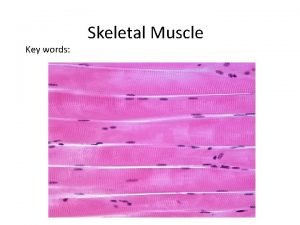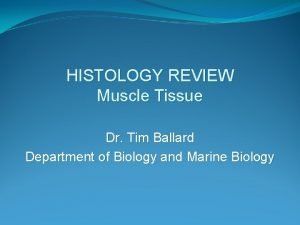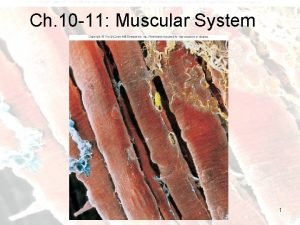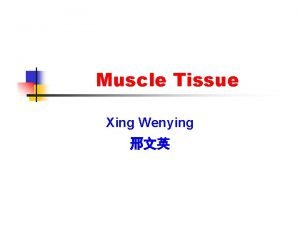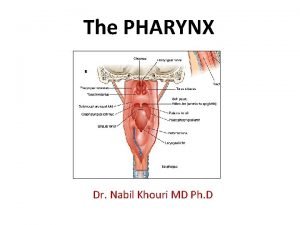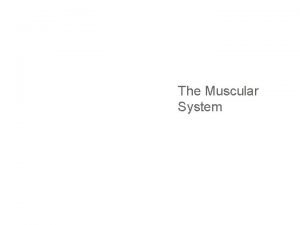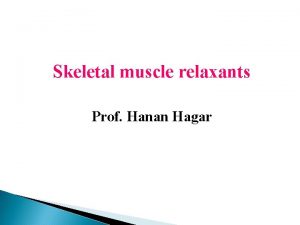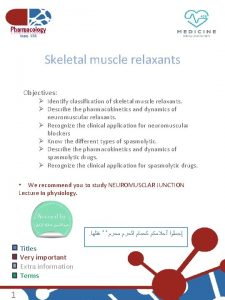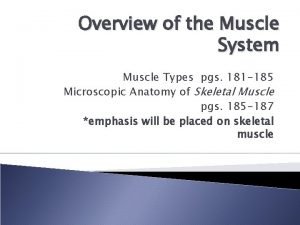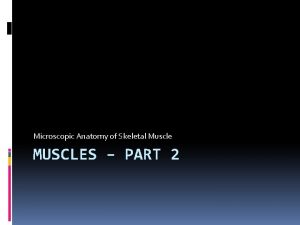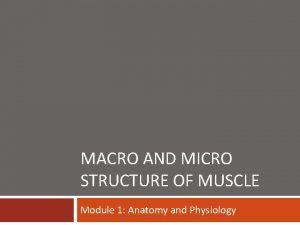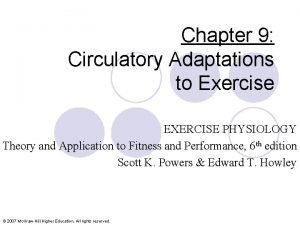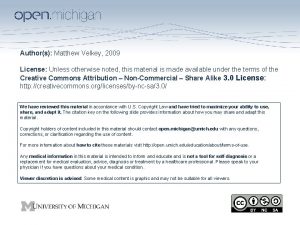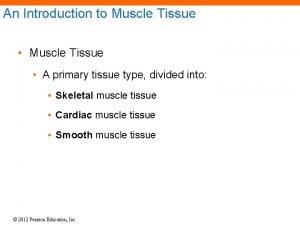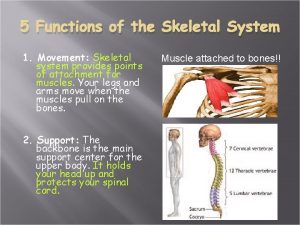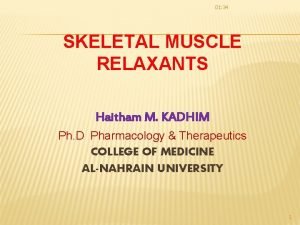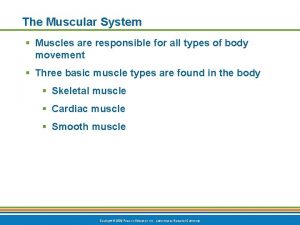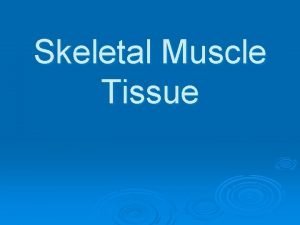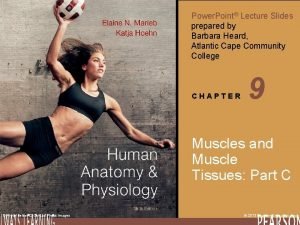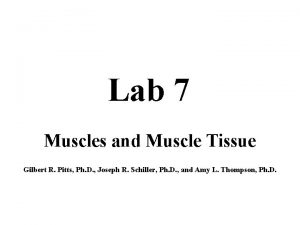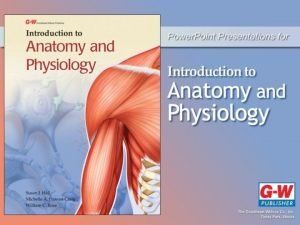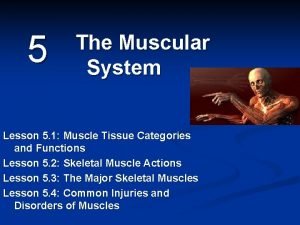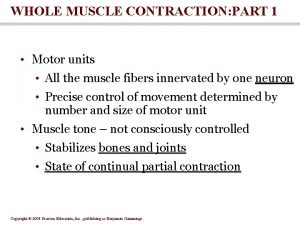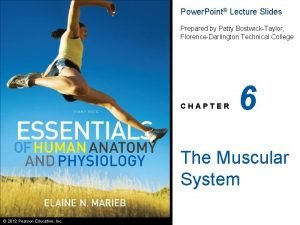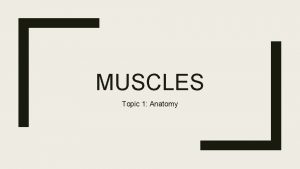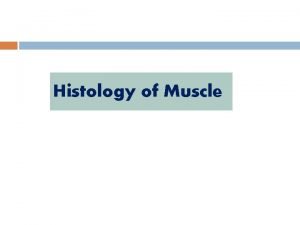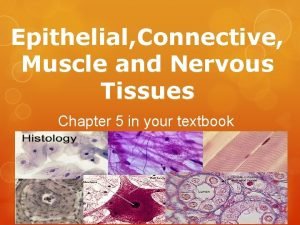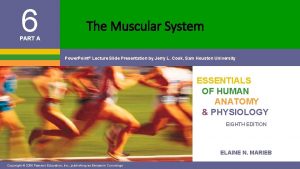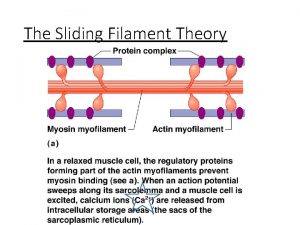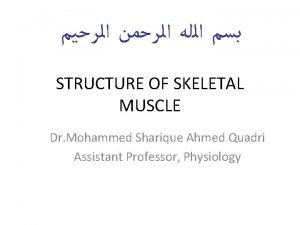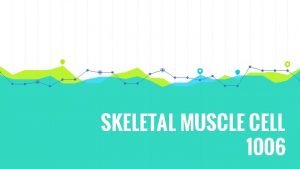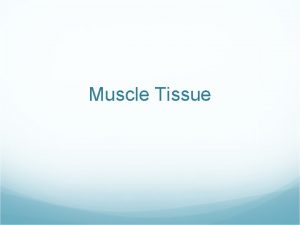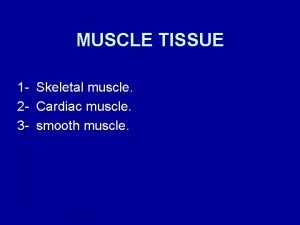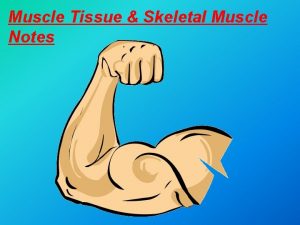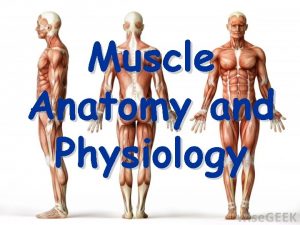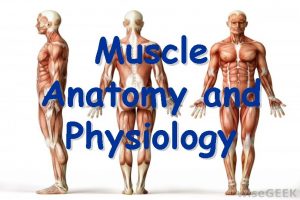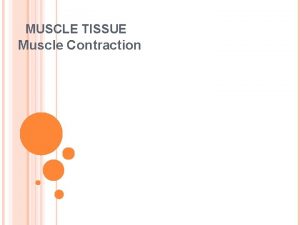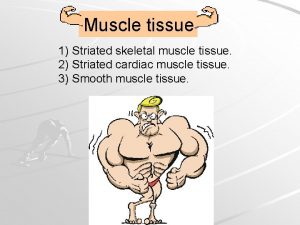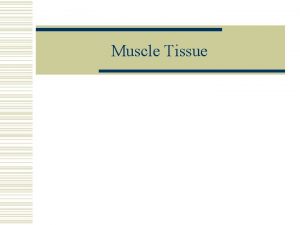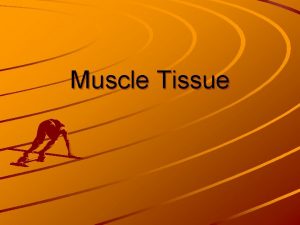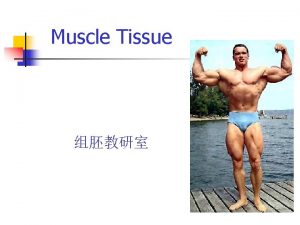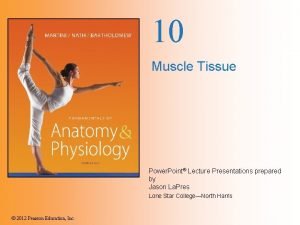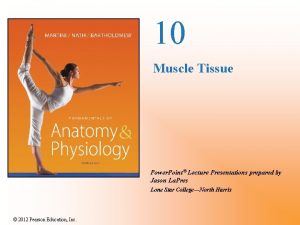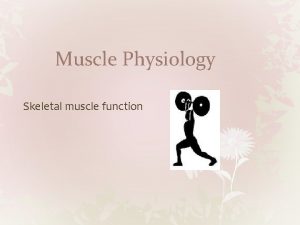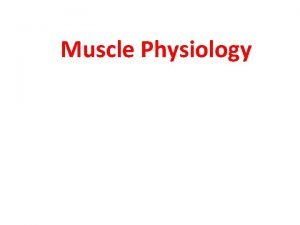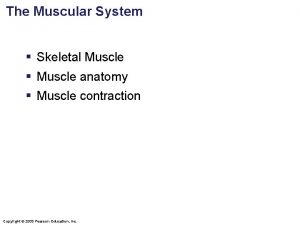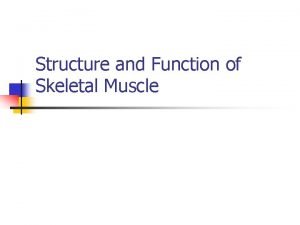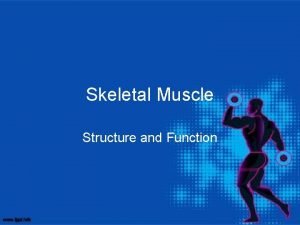10 Skeletal Muscle Tissue Power Point Lecture Presentations












































- Slides: 44

10 Skeletal Muscle Tissue Power. Point® Lecture Presentations prepared by Leslie Hendon University of Alabama, Birmingham © 2014 Pearson Education, Inc.

I. Muscle A. Muscle = a Latin word for “little mouse” 1. skeletal muscle 2. cardiac muscle tissue 3. smooth muscle tissue © 2014 Pearson Education, Inc.

Properties of Muscle Tissue Contractility ► Myofilaments are responsible for shortening of muscles cells ► Actin and myosin are two type of myofilaments Excitability ► Nerve signals excite muscle cells Extensibility ► Contraction of a skeletal muscle stretches the opposing muscle ► Smooth muscle is stretched by substances within that hollow organ ► Food in stomach; urine in urinary bladder Elasticity ► Recoils after being stretched © 2014 Pearson Education, Inc.

II. Terminology Specific to Muscle Tissue A. Myo- and mys- - prefixes meaning “muscle” B. Sarco—prefix meaning “flesh” 1. Sarcolemma - plasma membrane of muscle cells 2. sarcoplasm—cytoplasm of muscle cells © 2014 Pearson Education, Inc.

III. Functions of Muscle Tissue A. Produce movement 1. skeletal muscle - attached to skeleton (movement) e. g. biceps, triceps 2. smooth muscle - squeezes fluids through hollow organs e. g. walls of intestines and arteries B. Maintain posture and stabilize joints 1. enables the body to remain sitting or standing 2. muscle tone helps stabilize many synovial joints © 2014 Pearson Education, Inc.

C. Heat generation 1. muscle contractions produce heat 2. helps maintain normal body temperature © 2014 Pearson Education, Inc.

IV. Types of Muscle Tissue A. Skeletal muscle tissue 1. packaged into skeletal muscles 2. makes up 40% of body weight 3. cells are striated 4. innervated by voluntary division of the nervous system © 2014 Pearson Education, Inc.

C. Cardiac muscle tissue 1. occurs only in the walls of the heart 2. cells are striated 3. contraction is involuntary D. Smooth muscle tissue 1. occupies the walls of hollow organs 2. cells lack striations 3. innervated by involuntary division of the nervous system © 2014 Pearson Education, Inc.

V. Gross Anatomy of a Skeletal Muscle A. Sheaths of connective tissue 1. epimysium - surrounding entire muscle 2. perimysium - surrounds each fascicle (bundle of fibers) 3. endomysium - wrapping each muscle cell © 2014 Pearson Education, Inc.

Epimysium Bone Epimysium Perimysium Endomysium Tendon Muscle fiber in middle of a fascicle Blood vessel Fascicle (wrapped by perimysium) Endomysium (between individual muscle fibers) Epimysium Perimysium Fascicle Endomysium © 2014 Pearson Education, Inc. Muscle fiber

B. Each skeletal muscle supplied by branches of ► one nerve ► one artery ► one or more veins C. Nerves and vessels branch repeatedly D. Smallest branches serve individual muscle fibers E. Muscle attachments ► origin - less movable attachment ► insertion - more movable attachment © 2014 Pearson Education, Inc.

Muscle contracting Origin Stable Insertion moving © 2014 Pearson Education, Inc.

F. Muscles attach by connective tissue (CT) 1. fleshy attachments - CT fibers are short 2. indirect attachments - CT forms a tendon or aponeurosis G. Bone markings present where tendons meet bones ► tubercles ► trochanters ► crests © 2014 Pearson Education, Inc.

H. skeletal muscle cell (fiber) 1. fibers are long and cylindrical ► Are huge cells—diameter is 10– 100 µm ► Length—several centimeters to dozens of centimeters 2. cells are multinucleate 3. nuclei are peripherally located © 2014 Pearson Education, Inc.

Muscle >>> Fascicle >>> Muscle Cell >>> Myofibrils ► Are long rods within cytoplasm ► Make up 80% of the cytoplasm ► Are a specialized contractile organelle found in muscle tissue ►Are a long row of repeating segments called sarcomeres © 2014 Pearson Education, Inc.

Muscle Cell >>> Myofibril Sarcolemma Muscle cell Mitochondrion Myofibril Dark A band Light I band © 2014 Pearson Education, Inc. Nucleus

Myofibril >>> Sarcomeres Thin (actin) filament Thick (myosin) filament © 2014 Pearson Education, Inc. Z disc I band H zone A band Sarcomere Z disc I band M line

VI. Sarcomeres A. Basic unit of contraction of skeletal muscle Z line - boundaries of each sarcomere ► Thin (actin) filaments—from Z disc to center of the sarcomere ► Thick (myosin) filaments—located in the center of the sarcomere A bands - full length of the thick filament H zone - center part of A band where no thin filaments occur M line - in center of H zone I band - region with only thin filaments © 2014 Pearson Education, Inc.

muscle cell Sarcolemma Mitochondrion Myofibril Dark A band © 2014 Pearson Education, Inc. Light I band Nucleus

myofibril Thin (actin) filament Thick (myosin) filament © 2014 Pearson Education, Inc. Z disc I band H zone A band Sarcomere Z disc I band M line

sarcomere Z disc M line Z disc Thin (actin) filament Elastic (titin) filaments Thick (myosin) filament Myosin heads © 2014 Pearson Education, Inc.

VII. Sarcoplasmic Reticulum and T Tubules A. Sarcoplasmic reticulum 1. specialized smooth ER 2. contains calcium ions - released when muscle is stimulated 3. calcium ions diffuse through cytoplasm ► Trigger the sliding filament mechanism B. T tubules - deep invaginations of sarcolemma © 2014 Pearson Education, Inc.

Sarcoplasmic Reticulum and T Tubules Part of a skeletal muscle fiber (cell) I band Z disc A band H zone I band Z disc M line Myofibril Sarcolemma T Tubules of the sarcoplasmic reticulum Myofibrils © 2014 Pearson Education, Inc.

VIII. Mechanism of Contraction A. Two major types of contraction 1. Concentric contraction – force as muscle shortens 2. Eccentric contraction - force as muscle lengthens © 2014 Pearson Education, Inc.

Sliding Filament Mechanism of Contraction Thick (myosin) filament Thin (actin) filament Movement Myosin head Thick (myosin) filament © 2014 Pearson Education, Inc. Thick (myosin) filament Myosin heads

Sliding Filament Mechanism of Contraction 1 Fully relaxed sarcomere of a muscle fiber Z I H A © 2014 Pearson Education, Inc. 2 Fully contracted sarcomere of a muscle fiber Z Z I I Z A I

Muscle >>> muscle fiber © 2014 Pearson Education, Inc.

muscle fiber >>> myofibril >>> sarcomere © 2014 Pearson Education, Inc.

sarcomere © 2014 Pearson Education, Inc.

IX. Innervation of Skeletal Muscle A. Motor neurons innervate skeletal muscle tissue 1. neuromuscular junction - nerve ending meets muscle fiber 2. Terminal boutons (axon terminals) ► Located at ends of axons ► Store neurotransmitters 3. Synaptic cleft - between axon terminal and sarcolemma © 2014 Pearson Education, Inc.

neuromuscular junction Terminal bouton of nerve Synaptic cleft Terminal cistern of SR Triad Muscle fiber © 2014 Pearson Education, Inc.

Motor unit = motor neuron and muscle cells innervated Spinal cord Motor unit 1 Motor unit 2 neuromuscular junctions Nere Motor neuron cell body Motor neuron axon Muscle fibers © 2014 Pearson Education, Inc. Branching axon to motor unit

X. Types of Skeletal Muscle Fibers A. Skeletal muscle fibers categorized according to two characteristics 1. how they manufacture energy (ATP) 2. how quickly they contract B. Oxidative fibers - produce ATP aerobically C. Glycolytic fibers - produce ATP anaerobically by glycolysis © 2014 Pearson Education, Inc.

D. Slow oxidative fibers ► Red slow oxidative fibers E. Fast glycolytic fibers ► White fast glycolytic fibers F. Fast oxidative fibers ► Intermediate fibers © 2014 Pearson Education, Inc.

G. Slow oxidative fibers ► Contract slowly and resistant to fatigue ► Red color due to abundant myoglobin ► Obtain energy from aerobic metabolic reactions ► Contain a large number of mitochondria ► Richly supplied with capillaries ► Fibers are small in diameter © 2014 Pearson Education, Inc.

H. Fast glycolytic fibers ► Contract rapidly and tire quickly ► Contain little myoglobin and few mitochondria ► About twice the diameter of slow oxidative fibers ► Contain more myofilaments and generate more power ► Depend on anaerobic pathways © 2014 Pearson Education, Inc.

I. Fast oxidative fibers ► Contract quickly like fast glycolytic fibers ► Somewhat fatigue resistant ► Have an intermediate diameter ► Are oxygen dependent ► Have high myoglobin content and rich supply of capillaries ► More powerful than slow oxidative fibers © 2014 Pearson Education, Inc.

Skeletal vs. Cardiac vs. Smooth Muscle © 2014 Pearson Education, Inc.

Skeletal vs. Cardiac vs. Smooth Muscle © 2014 Pearson Education, Inc.

Skeletal vs. Cardiac vs. Smooth Muscle © 2014 Pearson Education, Inc.

Skeletal vs. Cardiac vs. Smooth Muscle © 2014 Pearson Education, Inc.

XI. Disorders of Muscle Tissue A. Muscular dystrophy 1. a group of inherited muscle destroying disease ► Affected muscles enlarge with fat and connective tissue ► Muscles degenerate ► Types of muscular dystrophy a. Duchenne muscular dystrophy b. Myotonic dystrophy © 2014 Pearson Education, Inc.

B. Fibromyalgia ► A mysterious chronic-pain syndrome ► Affects mostly women Symptoms fatigue sleep abnormalities severe musculoskeletal pain headache © 2014 Pearson Education, Inc.

XII. Formation of Skeletal Muscle Cell Embryonic mesoderm cells 1 © 2014 Pearson Education, Inc. Myotube (immature multinucleate muscle fiber) Myoblasts 2 Satellite cell 3 Mature skeletal muscle fiber
 Skeletal muscle tissue description
Skeletal muscle tissue description Muscle histology review
Muscle histology review Skeletal muscle tissue structure
Skeletal muscle tissue structure Smooth mucle
Smooth mucle Fusiform muscle
Fusiform muscle Slidetodoc
Slidetodoc 4 muscles of pharynx
4 muscles of pharynx Label the superficial muscles
Label the superficial muscles Centrally acting skeletal muscle relaxants
Centrally acting skeletal muscle relaxants Skeletal muscle relaxants classification
Skeletal muscle relaxants classification Non depolarizing muscle relaxant classification
Non depolarizing muscle relaxant classification Skeletal muscle relaxants classification
Skeletal muscle relaxants classification Movable muscle
Movable muscle Sarcoplasmic
Sarcoplasmic Skeletal muscle relaxants classification
Skeletal muscle relaxants classification Characteristics of skeletal smooth and cardiac muscle
Characteristics of skeletal smooth and cardiac muscle Microscopic anatomy of skeletal muscle
Microscopic anatomy of skeletal muscle Macro structure of muscle
Macro structure of muscle Organization of muscles
Organization of muscles Skeletal muscle pump
Skeletal muscle pump Skeletal muscle longitudinal section labeled
Skeletal muscle longitudinal section labeled Multinucleated muscle cells
Multinucleated muscle cells What is the 5 functions of the skeletal system
What is the 5 functions of the skeletal system Skeletal muscle relaxants classification
Skeletal muscle relaxants classification Microscopic anatomy of skeletal muscle figure 6-2
Microscopic anatomy of skeletal muscle figure 6-2 Chapter 6 the muscular system figure 6-9
Chapter 6 the muscular system figure 6-9 Nerve supply to muscles
Nerve supply to muscles Skeletal muscle belly
Skeletal muscle belly Slide
Slide Purpose of skeletal muscle
Purpose of skeletal muscle Skeletal muscle cylindrical
Skeletal muscle cylindrical Comparison of skeletal cardiac and smooth muscle
Comparison of skeletal cardiac and smooth muscle Lesson 5.1 the organization of a skeletal muscle
Lesson 5.1 the organization of a skeletal muscle Cross bridge cycle
Cross bridge cycle Lesson 5.1 the organization of a skeletal muscle
Lesson 5.1 the organization of a skeletal muscle Physiology of muscle contraction
Physiology of muscle contraction Characteristics of skeletal smooth and cardiac muscle
Characteristics of skeletal smooth and cardiac muscle Starter which muscles do you already know
Starter which muscles do you already know Cardiac muscle tissue
Cardiac muscle tissue When unstretched transitional epithelium
When unstretched transitional epithelium Microscopic anatomy of skeletal muscle figure 6-2
Microscopic anatomy of skeletal muscle figure 6-2 5 golden rules of skeletal muscle activity
5 golden rules of skeletal muscle activity Difference between troponin and tropomyosin
Difference between troponin and tropomyosin Is skeletal muscle an organ
Is skeletal muscle an organ Skeletal muscle autonomic nervous system
Skeletal muscle autonomic nervous system
